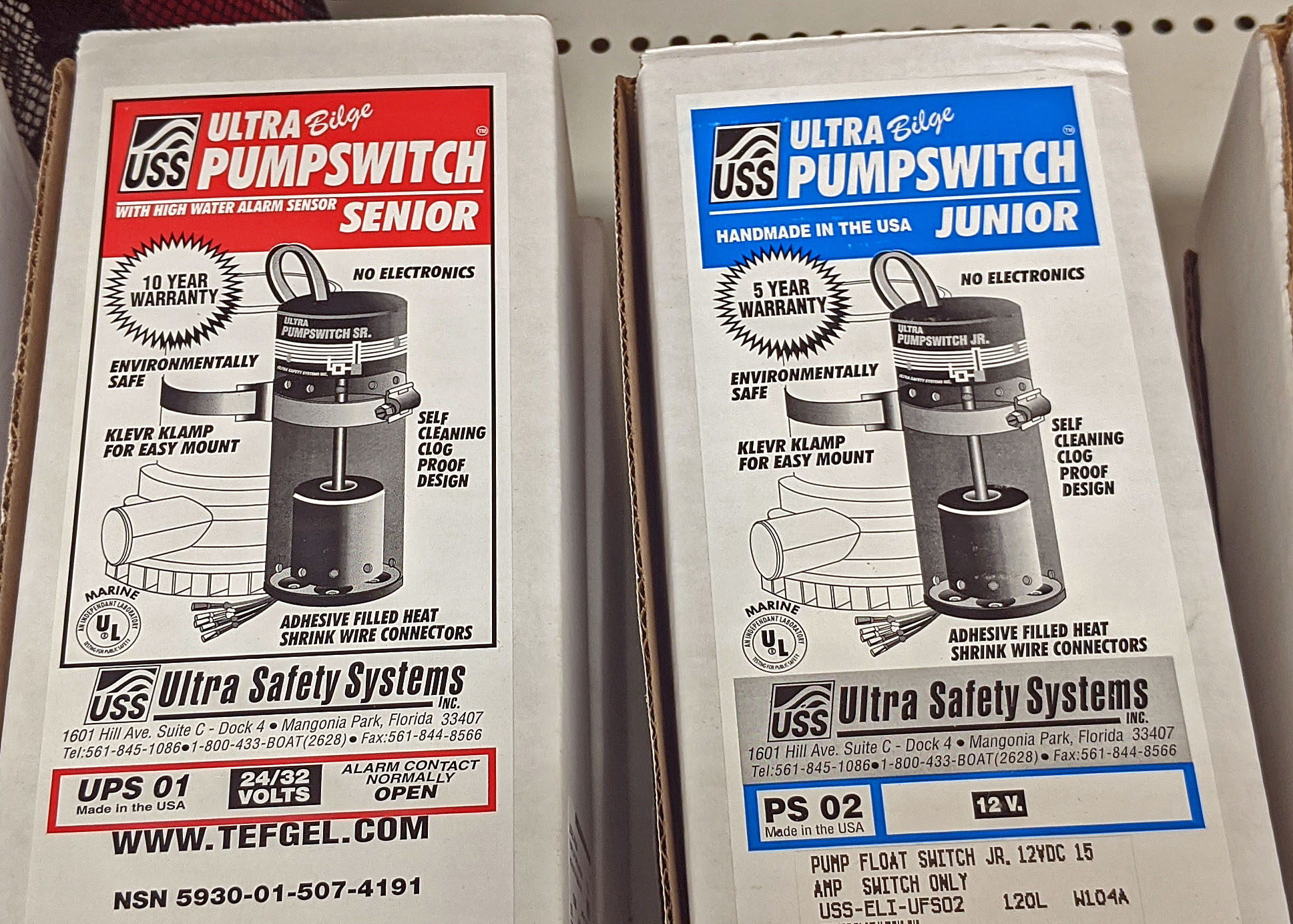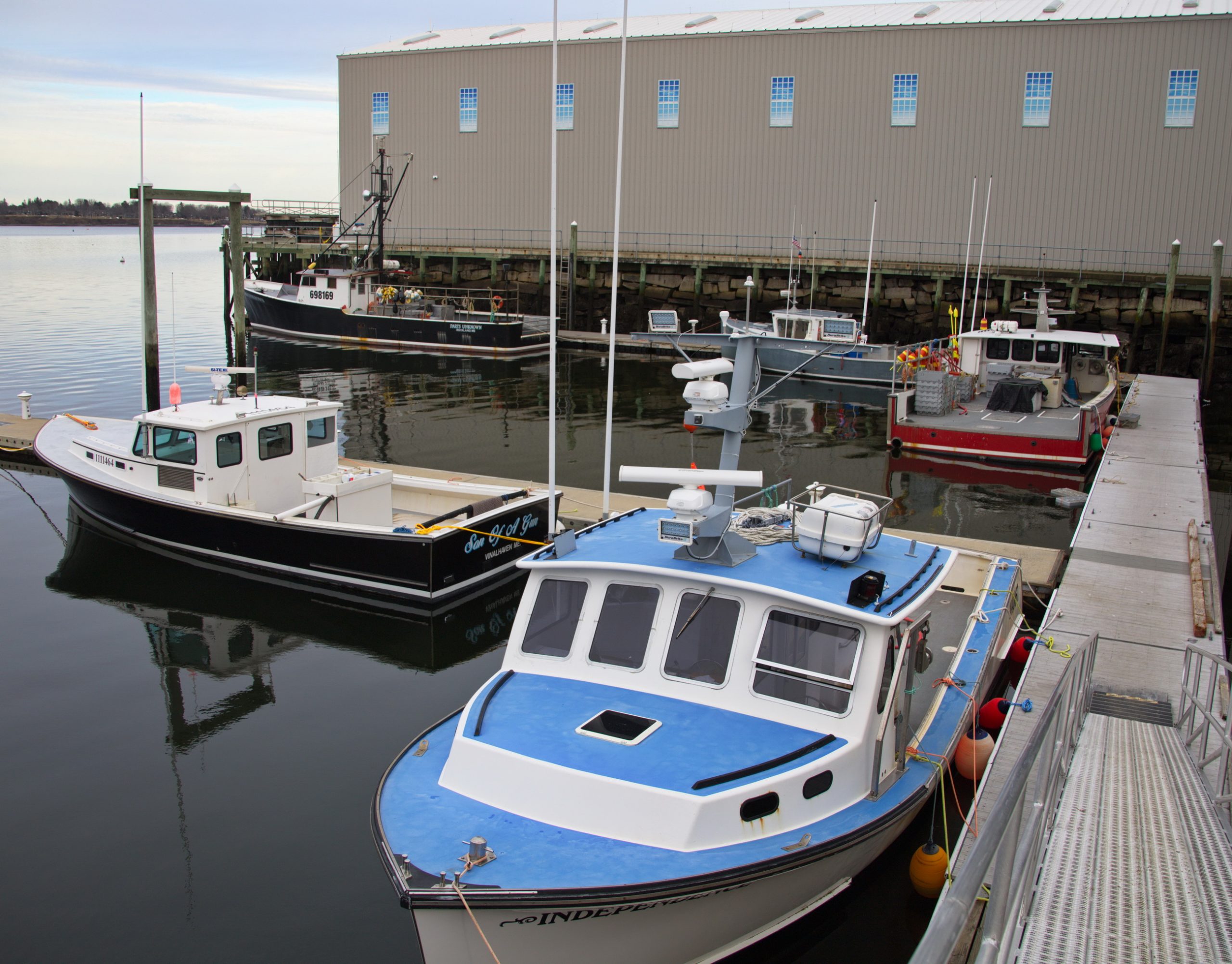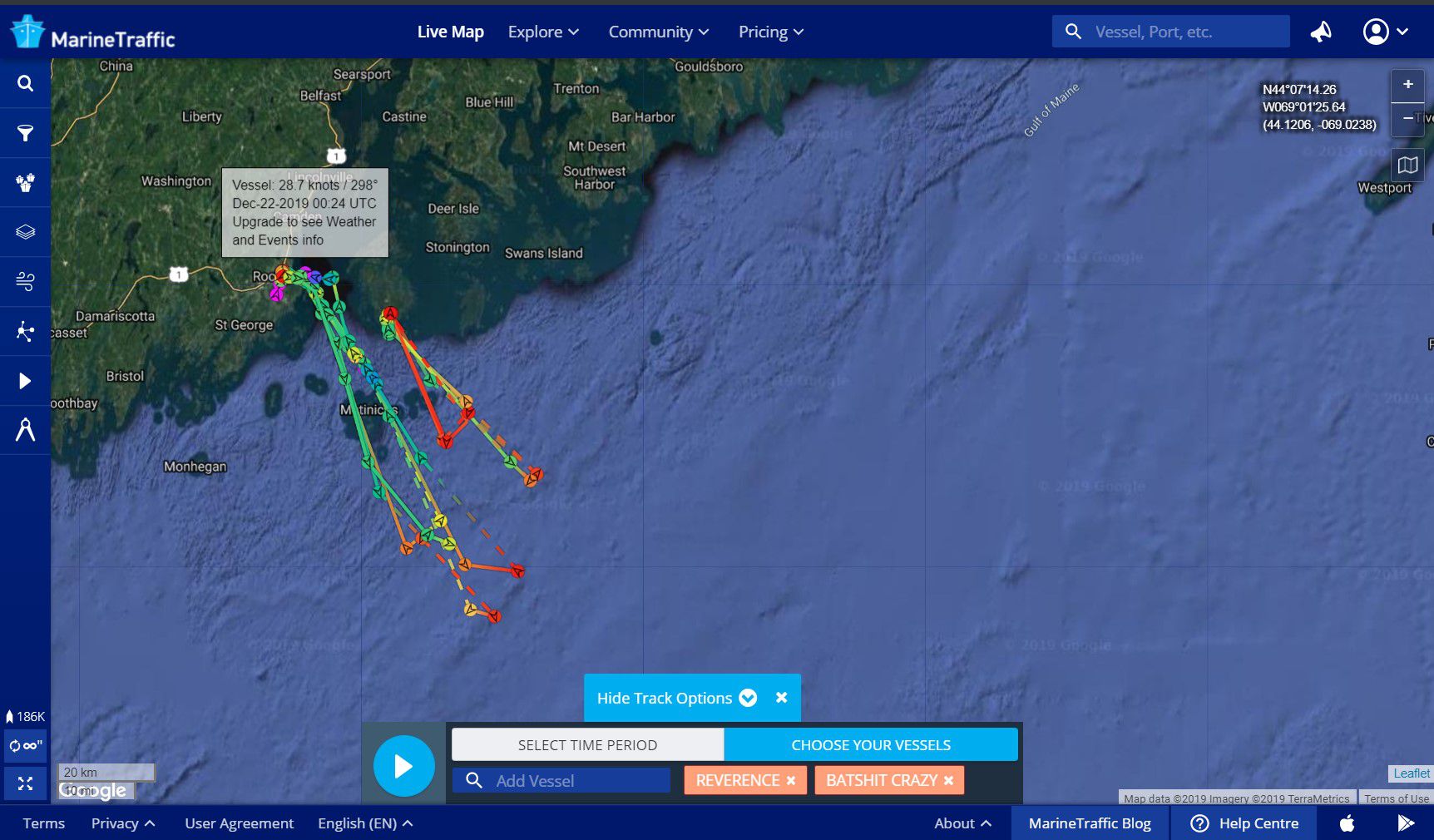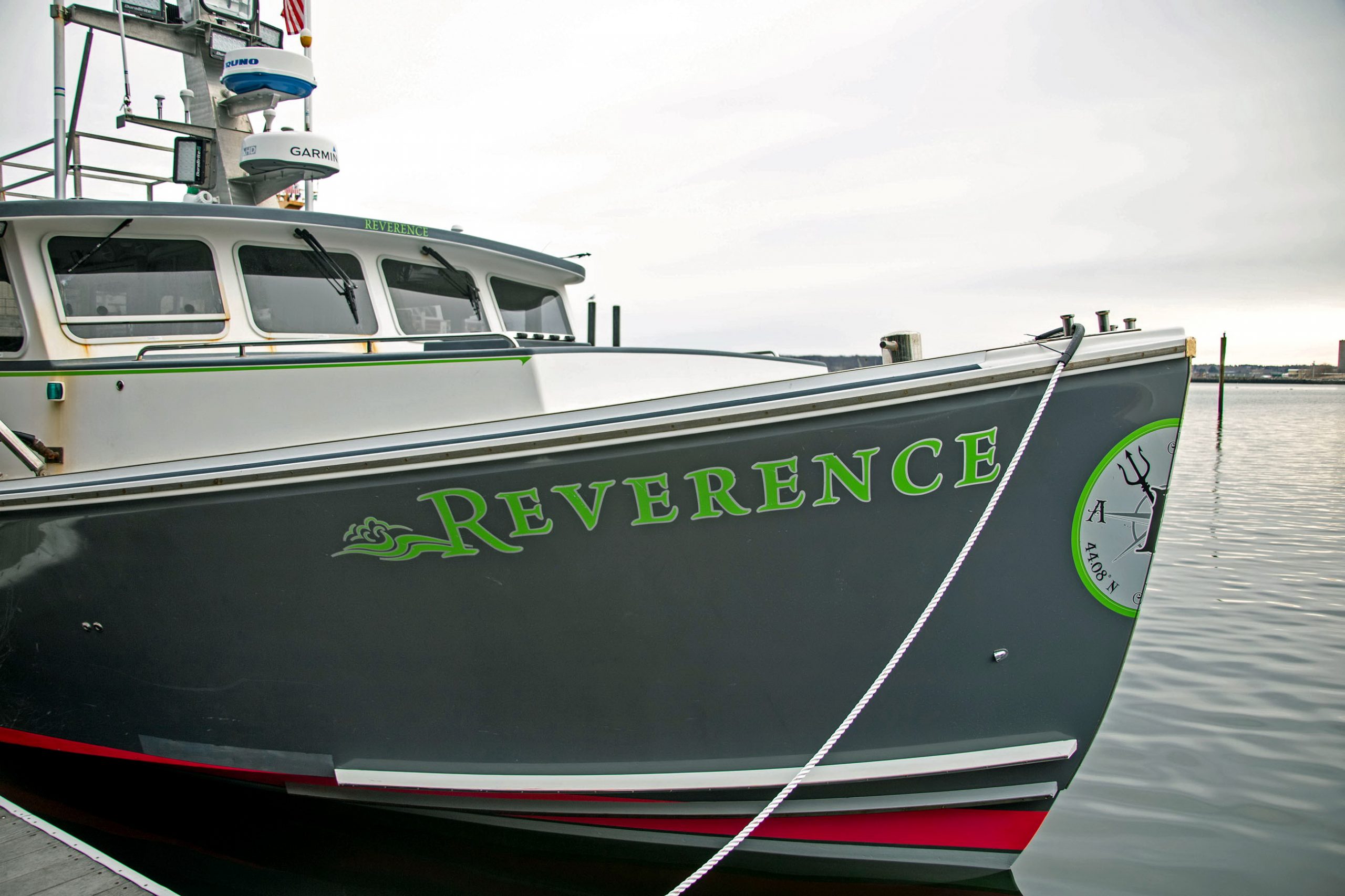Bilge pump switches, tough boats, and safe 2020 wishes to all

“NO ELECTRONICS” as a product feature? Is that where we’re at as the decades turn? But I also deduced evidence that these new-to-me USS Ultra bilge pump switches actually are ultra reliable. Despite premium pricing, the excellent marine chandlery in Rockland keeps plenty of Ultras in stock, and so they’re probably installed on some of the many nearby commercial vessels. Which especially includes the growing fleet of tough, handsome, and well-equipped offshore lobster boats that I’d like to tell you about.

I somehow missed them, but USS Ultra bilge pump switches have been around so long that some of the excellent reviews cover 20 years of service. And if price equals quality, they may be the most expensive float switches anywhere, with the retail $152 Junior model discounted to about $133 at Hamilton Marine (better than Amazon).
So the same size Ultra Senior with its built-in high water alarm plus the needed alarm panel totals $313 even at Hamilton. But the panel’s independent battery power is a smart feature given that failed boat batteries are one of the several ways that bilge pumps fail, and boats sink.
And note that for each of the three 12v Ultra switch sizes — the Mini really is smaller, and with a smaller On/Off differential for shallower bilges — there’s also a 24/32v model. I don’t understand why (what I think is) a “no electronics” magnetic float switch cares about voltage, but I’m not arguing with the Ultra track record and maybe a reader can explain what I’m missing?
Probably the best way to learn about USS Ultra switches is with their YouTube channel, and I particularly appreciated this wiring video. In my experience, failing wire connectors cause bilge pump problems about as often as the jamming of float switches (that aren’t as well protected as the Ultra design). I was also surprised by Ultra inventor Bob Mergenthaler’s tip about how to best use a butane lighter on his pump’s included adhesive shrink connectors, and look forward to trying it.
However, and even though I’m in the process of rebuilding Gizmo’s backup bilge pump system, I won’t be installing an Ultra switch myself. I’m quite satisfied with the solid-state SensaSwitch I first tested in 2005 (which is no longer available, but seems quite similar to the Johnson Pump Ultima). And I’m very pleased with the definitely electronic Blue Guard BG-One switch with oil and fuel detection that Ben Stein tested (and that I purchased from Hodges Marine).
Bilge pumps are important, and I plan to write more about my system as I perfect it. But let’s note now that Gizmo leads a very sheltered life compared to offshore lobster boats.

When I visit Gizmo in a Journey’s End Marina building these days, this is about a quarter of the fleet I get to see at their docks, if the weather is foul (Christmas day an exception). Apparently Maine offshore lobstering was rare in 2016, but that doesn’t seem true anymore. At least the three larger boats above show the signs — huge and well lit working decks, husky hardware, inside and outside helms, dual radars, multiple tall antennas, life rafts, all very well kept — and there are many more like them.

In fact, you can often glimpse the fleet in action on Marine Traffic, despite the fact that only about 10% use AIS (by my Rockland fleet estimate). This screenshot shows partial tracks for two boats this December, and represents some very long days of very hard work. Getting underway sometimes as early as 2 am, they steam out to Federal Lobster Management Area 1 with the crew probably stuffing bait bags along the way (decent documentary here).
Out there they can fish longer trawls of traps than are allowed or practical near shore, but picture the potential mess of lines and wire traps on deck when you haul, say, a 24-trap trawl, sorting catch and rebaiting as you go… in waters sometimes 500 feet deep. And don’t let a line snag your ankle during the reset.
Note too that the NOAA licenses are limited, so that’s often another significant expense in addition to the boat that’s up to the task. And regulations intended to protect endangered right whales may mandate minimal trawl sizes that upset many lobstermen. This is a serious and complicated business (and please understand that my understanding of it is darn thin).
But commercial lobstering in Maine is almost exclusively a one boat owner/operator enterprise, and one reason I’ve gotten so fascinated by the offshore fleet is the highly visible pride of ownership, along with the highly personal styling.
I’ve yet to see Batshit Crazy in the flesh, but regularly spotting it on AIS still makes me grin about how effective that name may be in foggy collision avoidance situations. BASHCRZY (apparently the owner/operator’s YouTube handle) represents what I think of as the heavy metal style, though I don’t actually know what comes out of the big deck speakers many of these boats sport.
Relentless is another good example of the style, seen above recently short hauled at JEM and below proudly hotdogging around Owl’s Head with Leviathan.
While Relentless is a Mussel Ridge 46 with a 1,000hp Cat C18, there are many big lobster boat designs around these days, as well documented by Brian Robbins in MBHH. Note what Robbins writes about how young many of the owner/operators are — which I’ve noticed in Rockland — and you may also enjoy his DownEast BoatPorn photo site.
A more traditional offshore style involves subtler colors with names referencing loved ones or maybe more esoteric subjects (Leviathan?).
Reverence is my favorite so far. I find the sometimes raced boat — a Wesmac Super 46 finished out by Clark Island Boat Works — tasty in every way from hull design to metalwork to color palette. And while I don’t think it’s necessary for a lobster boat to have a cool “bug” logo on its trap platform, or to be always left neat as a pin, I do suspect that these are signs of a vessel well and safely operated.

And isn’t Reverence simply a wonderful boat name, no matter how the owner/operator or any of us frame the word in our own hearts and minds? With that — and a morning glimpse of the little wannabee recreational lobster boat Junior — I’d like to wish all readers a safe and wondrous new year.























I guess it’s obvious that, at least temporarily, I’ve become an aging offshore lobster boat groupie, but here’s a good video — heavy soundtrack included — of what it’s like to haul and set a big trap trawl. Watch your feet!
https://youtu.be/7QDr-t5yVmI
I’m still looking something similar shot way offshore in winter conditions, but note that this same videographer, Terry Boivin, has posted numerous excellent new boat running vids with walkthroughs that show some of the sophisticated systems installed:
https://www.youtube.com/channel/UCJzxh1OUIFxlxAkK-Xe-HlA
Ben for you and Ben S Happy New Year.
Can you write what the boats use for such high antennas for MF/HF or VHF ?
Thanks, Chris, and great question. I just talked with Midcoast Marine Electronics, who fit out many of these boats, and they confirmed that almost all of those tall antennas are VHF. Specifically, they are one-piece 21-foot Shakespeare 476 Classic models, which apparently hold up to the stress, and Midcoast uses RG-213 coax to install them.
http://shakespeare-ce.com/marine/product/476-vhf-antenna/
They are expensive to ship but Hamilton Marine stocks them:
https://shop.hamiltonmarine.com/products/antenna-vhf-21–comm–grd-10-db-fbrgls-1-2-wave-30142.html
Thank you for your response .
I use long antennas VHF Comrod AV90BI16-2 from a good supplier
https://www.serviceport.se/en/products/antennas/comrod-antennas/marine-civil/vhf/comrod-av90bi16-2.html
Antenna front from a German manufacturer
https://www.ssb.de/en/coax/coaxial-cables/10-mm/ecoflex-10-plus-htx
Regards .
The Ultra switches use a magnetic reed switch to control power to a relay coil, the relay contacts then handle the high current switching for the Bilge pump. The voltage spec is for the relay coil. The Ultra switches are very robust and reliable. My previous Ranger Tug came with the electronic Johnson Ultima switches, 2 for Bilge pumps and one for the high Bilge alarm. 2 out of the 3 failed within 2 years. I used an an Ultra Junior to replace the failed Bilge pump switch and a Borel manufacturing reed float switch (low current) for the Bilge alarm. No electronics in the switches and now very robust. I like high tech but feel something as important as a Bilge switch should be simple, robust, and reliable.
Thanks, Howard. Relay voltages were also mentioned in a reader email, and make sense to me. And I will admit that it will be a long time before we know how long the (seem excellent) Blue Guard switches tend to last, and that Gizmo has two almost entirely independent bilge pump systems for a common bilge area — only the highly monitored battery bank is shared — plus several high water alarms 😉
After working with a number of muiltiplex system and seeing several lockup the entire boats electrical system in a failure, I tend to agree simple is better on saftey systems. Also a bit easier to trouble shoot in the middle of nowhere. I remember sitting at a dock on a 36′ production boat with a multiplex system trying to figure out the float switch wiring with an actual diagram and it still taking an hour due to the convoluted nature of the install.
We have multiple USS Ultra bilge pump switches on Visions of Johanna and have had a good experience with them over 16 years. We have fortunately, not tested them in an urgent situation! I have replaced one of five switches at the 12 year point when I noted improper status lights – which I think was due to a cable/wiring issue but I cannot definitively recall. USS will not allow any break or re-connection of their wire leash and it was necessary to replace the entire assembly. I ordered a spare with the replacement and now carry it aboard. I would choose them again.
Thanks, Bill, and readers should note that VOJ sailed a lot of the planet over those years, partially documented on Panbo:
https://panbo.com/racing-visions-of-johanna-two-handed/
Total miles logged so far?
I switched to an Ultra switch some years back as part of addressing a corrosion issue caused by a bad float switch. I like the Ultra. I do wish they would use tinned wire for their conductors, particularly given the price.
I have spent alot of time replacing bilge switches when I was a tech. I also heard alot about peoples struggles with them when I was designing and selling electrical systems. In general it seems the Ultra are the only almost universally praised switch out there. I really want to like the electronic ones (I have installed a number of water witches) but I have experienced issues with a couple where dirty water leaves a film and them seem to stay activated and also where they stop working with freshwater (rain).
All that said my own boats have rule float switches on them, but they are mostly day boats and an ultra would be a bit overkill on a 50 year old 19′ sailboat with a tight cabin and self bailing cockpit.
How about the Johnson ultima (bilge pump) switch?
Years ago, I installed Johnson Ultima switches on my own boat and several clients’ boats. All failed within a season or two. I now use only the USS switches that Ben describes above, and have yet to see a failure.
Though the USS Ultra Senior switches are good products, do not count on the manufacturer to stand by the warranty. When I purchased mine it was sold with a lifetime warranty (now it is 10 years). Though mine was installed per manufacturer’s instructions and had never been submerged, when it failed the manufacturer refused to honor the warranty. Though I liked the company, this experience soured me on the company.